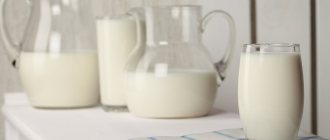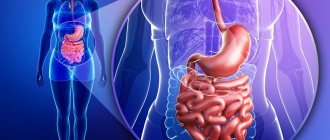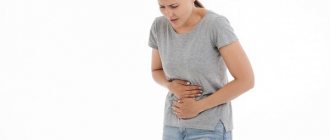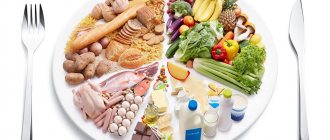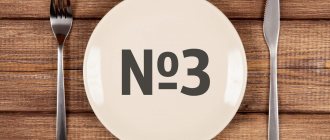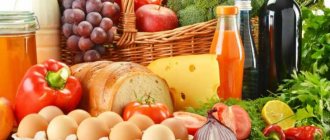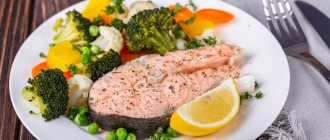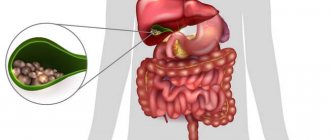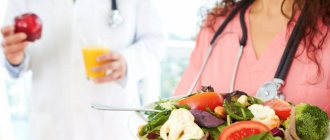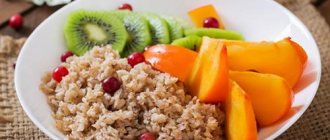When choosing a diet according to Pevzner, you need to be careful, because diet table No. 8 is aimed at losing weight.
Other diets simply have different types of calories. For example, table 5 according to Pevzner is recommended for those who suffer from diseases of the liver, gall bladder and biliary tract.
And here – I wrote about the benefits of turmeric.
For what diseases is it prescribed?
The diet is aimed at normalizing the functioning of the digestive organs, which are associated with the production and secretion of bile. This includes the liver, gallbladder and its ducts, and pancreas.
This therapeutic diet is indicated for the following diseases:
- chronic hepatitis;
- liver cirrhosis (in the absence of liver failure);
- chronic cholecystitis (inflammation of the gallbladder);
- gallstones;
- pancreatitis;
- gastroduodenitis;
- recovery period after removal of the gallbladder.
What is Diet No. 5 for?
Fatty fried foods are strictly prohibited on diet No. 5.
Table No. 5 is designed to provide the body with all the necessary nutrients: such a diet can be followed for years without harm to health. She helps:
- restore the functions of the biliary tract and liver,
- relieve fat and cholesterol metabolism;
- stimulate normal intestinal activity.
Such nutrition mechanically and thermally spares the stomach and intestines, the functions of which are also, as a rule, impaired by pathologies of the liver or pancreas.
Table Features 5
- Fractional meals. It is necessary to eat small meals up to 6 times a day. This significantly reduces the load on the digestive system and helps you lose excess weight.
- Food temperature. Do not eat very hot or very cold food. The most beneficial temperature for food on a diet is moderately warm.
- Water. The amount of water that needs to be consumed per day is from 1.5 to 3 liters.
- Fried, salted, pickled, spicy. All these foods must be excluded from the diet, as they negatively affect the functioning of the liver and gallbladder.
- Squirrels. It is necessary to consume plant proteins and animal proteins in a total amount of 50% of the daily diet.
- Vegetables and fruits. Replenish the body's need for carbohydrates with the help of raw vegetables and fruits allowed on the diet (see table).
- Salt. At table 5, the amount of salt is reduced to 8-10 grams per day.
There is a type of diet table No. 5 - this is the diet table 5A, which is prescribed for acute hepatitis and cholecystitis. The effect of this diet is aimed at relieving the acute stage of the disease, after which, as a rule, the patient switches to dietary table 5 to maintain remission.
What is the difference between diet table No. 5 and table 5A? The main difference with the main diet table 5 is that all vegetables and fruits must be heat treated. In addition to excluding fried, spicy, fatty foods, all organic acids from vegetables and fruits are also excluded.
One of the features of the 5A diet is the prohibition of foods that cause fermentation in the intestines. This is another reason why vegetables and fruits are served boiled or baked.
Diet 5a according to Pevzner
There is also a table for patients with cholecystitis in the active phase. Also, a therapeutic diet can be prescribed for hepatitis. The purpose of such nutrition is not to reduce calories, but to facilitate the work of the liver. At the same time, all necessary and important substances must be supplied to the body in sufficient quantities.
Diet 5a and recipes for dishes for every day are almost completely identical to the fifth table, only all dishes are served in ground form, without large pieces.
Prohibited products include:
- Any products made with yeast. Even dietary supplements and vitamins with brewer's yeast are contraindicated. They will cause fermentation and rotting in the gastrointestinal tract.
- Products containing soy and legumes.
- Processed cheese, glazed cheese curds, store-bought cottage cheese.
- Citrus.
- Collections containing lemon and other citrus fruits.
- Bran.
- Any fried food is completely excluded.
Also, you should not eat all those foods that are prohibited according to table No. 5. In principle, there are not many restrictions, but they must be followed strictly. After the active phase of cholecystitis has passed, you can slowly return to diet 5.
Also, therapeutic diet 5a can be used during recovery after major surgical interventions. Such nutrition will facilitate the work of the liver, and it will cope with the removal of residual substances from the anesthesia used. As a rule, a week on such a diet is enough, then it is expanded to the menu of the fifth table. Under no circumstances should you eat fatty foods in the first week after surgery. This threatens serious complications and liver problems in the future.
I created this project to tell you in simple language about anesthesia and anesthesia. If you received an answer to your question and the site was useful to you, I will be glad to receive support; it will help further develop the project and compensate for the costs of its maintenance.
Health problems are often associated with a person’s lifestyle and his reluctance to follow doctors’ recommendations.
However, when the body declares its problems with pain and other unpleasant sensations, you have to start taking care of yourself.
Some diseases, especially those affecting the digestive system, can be cured with proper nutrition.
Diet 5 table, what is possible and what is not (table)
Below in the table you can see what you can eat and what you cannot eat on a gentle diet of diet 5. Use this information when creating a menu for the week.
| Products | What can you eat | What not to eat |
| Flour | Dried yesterday's bread. Galette baked goods | Fresh bread. Delicious and fresh baked goods. Puff pastry. Pancakes, pancakes, pies |
| Meat and poultry | Lean types of meat (veal, beef, rabbit, turkey fillet, chicken). Can be eaten boiled or baked | Fatty meats. Sausages. Roasted meat and poultry. Salo |
| Fish | Low-fat fish (pike perch, cod, perch) boiled or as a soufflé | Canned food. Fatty fish, smoked, salted fish |
| Cereals | Porridges made from buckwheat, oatmeal, semolina and rice cooked in water. The porridge is viscous, boiled. Puddings and casseroles made from these cereals are acceptable. Table 5 rules allow pasta made from durum wheat | Legumes, pearl barley, millet, corn grits |
| Soups | Slimy soups from permitted cereals, cooked in vegetable broth, or pureed soups | Borscht, okroshka, beetroot soup. Meat broth soups |
| Eggs | Protein omelet (1-2 pieces per day). Half a yolk per day is allowed | You should not eat hard-boiled or fried eggs. |
| Dairy | Low-fat milk, cottage cheese, yogurt, cheese | Fat cottage cheese, sour cottage cheese, fatty and spicy cheeses, ice cream, cream |
| Vegetables | Cucumbers, tomatoes, carrots, cabbage, and greens can be eaten raw. Beets, carrots, zucchini, cauliflower, potatoes, onions are consumed boiled | Salted, pickled vegetables. Raw onion. Garlic, radish, sorrel, mushrooms, spinach |
| Fruits | Apples, pears, bananas, melons, peaches, watermelon. Non-acidic berries: raspberries, strawberries, blueberries. Dried fruits: prunes, dried apricots, dates, raisins | Nuts. Sour fruits and berries |
| Sweets | Honey, pastille, jam, marmalade, marshmallows | Chocolate. Ice cream. Confectionery products containing margarine and butter |
| Beverages | Weak green tea, rose hip decoction, fruit juices diluted half and half with water. Non-acidic dried fruit compotes | Alcohol, coffee, cocoa. Strong black or green tea. When following a diet, do not drink drinks with ice. |
Authorized Products
Table No. 5 according to Pevzner necessarily contains low-fat cottage cheese and milk. Complete protein nutrition, which is provided by dairy products on the menu, is not burdened by purines, uric acid and cholesterol contained in meat. The content of proteins and carbohydrates in the menu is reduced, so the recipes are low-calorie and the calorie content per day is about 1800 kcal.
Table No. 5 recommends eating strictly five times a day, in small portions. You can eat 2-3 eggs per week. Limit the consumption of vegetables, fruits and recipes for dishes made from them, which can cause flatulence. You can't eat sour sauerkraut.
Chemical composition of the diet per one lazy day of eating: 200 g of carbohydrates; 80 g protein, 60 g fat. A sufficient intake of vitamins and microelements into the body is necessary, so recipes made from fresh vegetables and fruits are useful. It is necessary to drink at least one and a half liters of pure mineral water and herbal tea per day.
List of foods that can be eaten for gastritis, pancreatitis, hepatitis:
- Milk, kefir, low-fat cheese, cottage cheese should be on the menu every day.
- Lean beef, rabbit, turkey, chicken fillet.
- Low-fat fish (hake, cod, pike perch).
- Wheat stale bread, oatmeal cookies.
- Vegetarian soups with cereals, pasta, without onions, dressing and hot spices.
- Butter and vegetable oil in a certain amount.
- Non-acidic berries and fruits, dried fruits.
- Vegetables that do not contain oxalic acid are not spicy or bitter.
- Cereals include semolina, oatmeal, rice and buckwheat.
- You need to drink pure mineral non-carbonated water and permitted drinks: compotes, herbal teas, non-acidic juices, chicory.
- Allowed sweets include marshmallows, marmalade, honey (possible in the absence of contraindications).
Prohibited foods for gastritis, pancreatitis, hepatitis:
- You cannot eat hot seasonings and spices: horseradish, mustard, pepper.
- Lard, smoked, dried, fried meat and fish products, fatty pork, all types of canned meat and fish.
- Soups with meat, mushroom, fish, bone, and chicken broths.
- You cannot eat buns, freshly baked bread, or cakes.
- Black tea, chocolate, coffee, carbonated drinks, alcohol.
- Vegetables: sorrel, onions, radishes, parsley, radishes, cucumbers, garlic, spinach.
- Marinades, pickles from vegetables and mushrooms.
- No sour fruits.
- Beans, pearl barley, millet, corn and barley cereals.
- Meat by-products: liver, heart, lungs, etc.
How to create a sample menu
To create an approximate menu for a week for diet table No. 5, you must adhere to several rules:
- at least 5-6 meals, between them you can add snacks in the form of fruit (apples, bananas, dried fruits, biscuits);
- Try to make every meal satisfying, but the amount of food should be small, because the main rule on the diet is split meals;
- Every day it is necessary to include fresh vegetables and fruits in the menu;
- several times a day you need to eat protein foods: low-fat cottage cheese, fish, meat;
- combine fish and meat with fresh vegetables;
- in addition to compotes and tea, drink a lot of water;
- in order for the table 5 diet menu dishes to be varied, but not take a lot of time, use freezing (freeze, for example, applesauce from baked apples, semi-finished lazy dumplings, cottage cheese casserole, soups, etc.), this will significantly save time and the diet will not be repeated for 2-3 days.
Pevzner diet 5p: weekly menu for pancreatitis
This table has a branch. For patients with pancreatitis, it is necessary to follow a special diet according to Pevzner 5p. This diet is designed for those who have chronic pancreatitis. The therapeutic diet took table number 5 as a basis, but added some exceptions.
- White sugar. Only 20 grams of xylitol can be added to dishes.
- Avoid hot and cold foods. That is, all food should be slightly warm or at room temperature.
- Any products containing palm oil.
- Beetroot soup, okroshka.
- Sweets.
In all other respects the table is exactly the same as No. 5. It takes at least a couple of months for diet number 5p according to Pevzner to produce results; it is better to prepare the menu for the week in advance to reduce the risk of eating something forbidden.
This diet is perfect for the postoperative period. You can stick to it for the first two weeks of recovery, and then smoothly move to table No. 5.
Diet menu table number 5 for the week
| Day of the week | Breakfast | Lunch | Dinner | Afternoon snack | Dinner |
| Monday | Oatmeal in water with mashed banana and sweet berries (previously defrosted to room temperature, or fresh), green tea with honey | Steamed omelette, marmalade | Cauliflower and carrot soup, chicken pudding, cucumber and tomato salad, dried fruit compote, sweet crackers | Cottage cheese with low-fat sour cream and sugar | Stewed pike perch, vegetables, compote |
| Tuesday | Cottage cheese casserole with sour cream sauce (remember that diet 5 uses low-fat sour cream) | Fruits (banana, apples) | Vegetable soup with meatballs, pilaf, tomatoes, green tea | Baked apples with honey | Baked fish fillet, Chinese cabbage salad with low-fat sour cream |
| Wednesday | Steamed lazy dumplings with fruits and berries, fruit juice | Meat puree, fresh vegetable salad, biscuits, green tea | Fish soup, steamed rabbit cutlets, buckwheat porridge, vegetables stewed in water, fruit juice | Banana casserole with cottage cheese and sour cream, compote | Steamed omelette, kefir |
| Thursday | Cauliflower casserole with sour cream sauce, fruit | Baked apples with cottage cheese and banana | Broccoli soup, turkey and potato stew, fresh vegetable salad, marshmallows, juice (according to the diet, it is better to refrain from dessert if you feel full) | Zucchini stew, biscuits, tea | Cottage cheese with raspberry jam, kefir |
| Friday | Oatmeal with fruits and sweet berries, green tea | Stuffed zucchini, greens, compote | Buckwheat soup, navy pasta, fresh vegetable salad, fruit juice, marshmallows | Applesauce, biscuits | Lazy dumplings with honey, kefir |
| Saturday | Cottage cheese, banana and apple puree, green tea | Cauliflower and zucchini stew | Chicken noodle soup, turkey meatballs, fresh vegetable salad, marmalade, compote | Baked fish, Chinese cabbage salad | Galette cookies, low-fat yoghurt with fruit puree |
| Sunday | Lazy dumplings with honey, kefir | Vegetable puree soup, fruit juice | Rice soup, cabbage rolls, mashed potatoes, fresh vegetable salad, green tea | Stewed fish with tomatoes, compote | Cottage cheese with raspberry jam, compote |
Here is an example of how you can create a completely varied diet from the same products on the Table 5 diet. But the essence of this diet is not in variety, but in medicinal properties. The main task is not the number of new dishes every day, but their quality from a medical point of view.
Diet 5 zucchini dishes. 5 amazing diet dishes with zucchini
All the best for your health!
1. Zucchini breaded with soft cheese
Ingredients:
- Zucchini - 500 g
- Egg - 2 pcs
- Hard cheese 100 g
- Dry herb mixture as desired
- Salt, pepper - to taste
Preparation:
Peel the zucchini and cut into sticks. Beat the egg with salt and pepper, grate the cheese on a fine grater, add herbs and mix. Dip each stick in egg, bread in cheese, and place on a baking sheet lined with baking paper. Bake the zucchini in a preheated oven at 180 degrees until golden brown. Eat warm.
2. Chicken cutlets with carrots and zucchini
Ingredients:
- Minced chicken fillet - 200 g
- 1 large carrot
- 1 small zucchini (500 grams)
- 1 onion
- 1 protein
- Spices to taste
Preparation:
Grate carrots, zucchini and onions on a coarse grater, mix with minced meat, egg and spices. Form cutlets with wet hands and bake in the oven at 180° until golden brown (20-40 minutes depending on size).
3. Zucchini Lasagna: A super healthy dinner!
Ingredients:
- Chicken fillet – 300 g
- Zucchini – 400 g
- Carrots – 1 pc.
- Egg – 1 pc.
- Onion – 1 pc.
- Natural yogurt – 4 tbsp. l
- Low-fat cheese – 100 g
- Tomato paste – 1 tbsp. l
- Salt, pepper - to taste
Preparation:
Grind chicken fillet into minced meat. In a frying pan, fry minced chicken, chopped onion, grated carrots with a little oil, add a little water and simmer for 10 minutes over low heat. Add tomato paste and fry for 3 minutes, stirring constantly. Add salt and pepper to taste. Cut the zucchini into thin layers.
Place half the squash layers in a fireproof dish with a flat bottom. Place half of the fried minced meat on the zucchini. In a bowl, whisk the egg with yogurt and salt. Pour half of the egg-yogurt mixture onto the minced meat. Then repeat all layers. Sprinkle with grated cheese and place in an oven preheated to 200 degrees until done. Once the zucchini has become soft and the cheese has browned, you can remove it from the oven. Lasagna is ready, serve hot.
4. Zucchini stuffed with chicken
Ingredients:
- Zucchini - 4 pcs
- Chicken fillet – 600 g
- Onion - 1/2 pcs
- Lemon zest - 1 pc.
- Garlic – 7 g
- Mixture of Provencal herbs - 1 tsp
- Salt, pepper - to taste
Preparation:
Grind the chicken fillet into minced meat. Using a teaspoon, scrape out the pulp from the zucchini - a boat with walls about 1 cm thick or a little less should remain. Place the boats on a baking sheet and add salt. Finely chop the removed pulp and add to the minced meat along with lemon zest, grated garlic, finely chopped onion, herbs, salt and pepper. Knead. Place into zucchini. Place in an oven preheated to 200 degrees and bake until done, about 30-35 minutes.
5. Zucchini baskets
Ingredients:
- Zucchini - 500 g
- Chicken fillet – 200 g
- Salt, spices - to taste
- Egg - 1 pc.
- Low-fat cheese – 50 g
- Olive oil
Preparation:
Peel the zucchini and grate on a coarse grater. Squeeze out the liquid, add the egg, salt and mix well. Cut the chicken fillet into small cubes, add salt, sprinkle with spices and fry for 5 minutes. Distribute the zucchini mass over the bottom and walls of the silicone molds. Place the chicken fillet in the center. Sprinkle with grated cheese. Place in the oven preheated to 200*C for 30 minutes.
Enjoy!
Dish recipes
Creamy cauliflower soup
Soups and puree soups are very beneficial for the gastrointestinal tract if prepared in vegetable broth. Table No. 5 involves daily consumption of a variety of soups.
- bulb;
- carrot;
- cauliflower (small head);
- vegetable broth;
- 1 tbsp. low-fat sour cream;
- salt;
- vegetable oil.
Peel the onions and carrots. Cut the onion into pieces, chop the carrots using a grater.
Add 2 tablespoons of oil to the pan. When it warms up, fry the onions and carrots for 2-3 minutes over low heat. Next, pour a little broth into the pan to slowly simmer the vegetables. Cover with a lid.
Disassemble the cabbage into small inflorescences and wash them. After 5-7 minutes, add the cabbage to the pan. Pour in vegetable broth. Cook for 20 minutes. When the soup has cooled, blend it with a blender. Before serving, add a pinch of salt and a spoonful of sour cream.
Curd casserole with dried fruits
- 300 grams of cottage cheese;
- 1 egg, 1 white;
- 5 tablespoons of semolina;
- 3 tablespoons of kefir;
- dried fruits (dried apricots, prunes, raisins) or sweet fruits, berries (fresh, frozen);
- 0.5 teaspoon of soda;
- sugar to taste.
Mash the cottage cheese, add soda, sugar, egg, semolina, kefir, chopped dried fruits or fresh fruits, cut into pieces. Grease the mold with oil. Bake in the oven at 200 degrees for 40-50 minutes. Remember that on diet table 5, heavily baked edges cannot be eaten.
Gentle nutrition is an effective addition to drug treatment of the liver and gallbladder. If a patient is prescribed a diet of table 5, then, if all its rules are followed, the remission of the disease will be stable and long-term. In addition, the amount of necessary medications will be significantly reduced, which will also have a beneficial effect on the entire body.
Quick page navigation
Diet table No. 5 is one of the most common among patients suffering from gastroenterological diseases. Successful therapy of any organ requires a reduction in the functional load on it through correction (sometimes significant) of the diet.
Under conditions of a gentle diet, the digestive system is restored and stabilized over time, after which the patient feels significant relief.
That is why healing diseases of the biliary tract, liver and pancreas is impossible without strictly following the therapeutic diet according to M.I. Pevzner called table 5. Gastroenterologists and experienced nutritionists prescribe this menu to patients with the following ailments:
- pancreatitis (reactive, acute, chronic);
- cholecystitis;
- cholelithiasis;
- hepatitis (chronic);
- cirrhosis of the liver.
Diet No. 5: recipes
• Beet and prune salad.
200 g of beets are boiled, peeled and cut into bars or grated on a coarse grater. A couple of hours before preparing the salad, soak 70 g of prunes in boiling water, then drain the water and finely chop it into pieces. Add a little salt and 40 g of low-fat sour cream.
• Rice and apple porridge.
2 medium apples are cut into small pieces, after cutting out the core, and placed in boiling water diluted in half with milk (1 glass of water + 1 glass of milk). After 5 minutes, add half a glass of rice and cook until tender. 5 minutes before the end of cooking, add 1 tablespoon of sugar and a little butter.
• Fruit salad.
To prepare the salad, you will need to peel and prepare 40 g of apples, 30 g each of tangerines, bananas and strawberries. Cut the fruit into pieces, sprinkle with sugar and add 30 g of low-fat sour cream.
• Carrot and banana salad.
Large carrots are peeled and grated on a coarse grater. The pulp of one banana is cut into pieces. Mix the ingredients, sprinkle with sugar and pour in 100 g of sour cream or homemade yogurt.
• Corn porridge with prunes.
50g of prunes are boiled in 200 ml of water and left for 30 minutes to swell. The prunes are taken out and 80 g of corn grits are added to the broth, where they are cooked until tender over very low heat. At the end of cooking, add a little salt and 10 g of butter.
• Milk-rice soup.
Boil 5 tablespoons of rice in 500 ml of boiling milk. When the soup is ready, remove it from the heat, cool, add a piece of butter and honey.
• Strawberry milk soup.
Add 1 cup of oatmeal to 1 liter of boiling milk. Bring to a boil, add 150 g of washed strawberries, 1 tablespoon of sugar and a little salt. Bring the soup to a boil, turn off and leave for 20 minutes. Can be consumed both cold and hot.
Tags: weight loss
Market Analytics
- Beauty of the future: cosmetic innovations 2020
- New ingredients are the driving force of the cosmetics industry
- Global Cosmetic Packaging Market – Focusing on Digital and Sustainability
Convenient search for beauty salons on our website
Beauty salons in Moscow Beauty salons in St. Petersburg Beauty salons in Ekaterinburg Beauty salons in Novosibirsk
Latest blog posts on our website
- Naturecream / Cleavage - a woman's passport
- Naturecream / Anti-cellulite “Memo”
- Naturecream / Peptides instead of beauty injections.
- Naturecream / Microplastics in cosmetics
- Naturecream / Sea buckthorn oil - “liquid gold” for the face
- Naturecream / Superfood for skin from Navarra
- Naturecream / Autophagy - prolonging skin youth
- Naturecream / Cosmetics Anti - pollution skin health in the metropolis
- Prostye-sovety / Hairstyles and haircuts for thick faces
- _angel_ / Korean cosmetics
Latest forum topics on our website
- Mrs._Smith / Badly sunburned! What to do?((
- Ice / Is it necessary to combine fitness classes with a diet?
- Antonova / What can be used for hair loss?
- Radio operatorKat / Who was on a protein diet?
- Suzanna / Mesotherapy on the face
Other articles in this section
| Vegetable diet A vegetable diet is a pleasant and healthy way to lose weight. It is not for nothing that many nutritionists advise their patients to eat more vegetables. Vegetables contain the fiber necessary for the body and are rich in minerals and vitamins. It is believed that a vegetable diet reduces the risk of cancer, obesity and atherosclerosis. How to make a proper diet and what vegetables to choose? We will try to cover it in more detail in our article. |
| Cabbage diet One of the best ways to lose weight is to eat a lot of vegetables, which contain fiber and many minerals - and the body is cleansed of toxins, and there is no shortage of nutrients. The cabbage diet for weight loss allows you to get rid of extra pounds because it is low in calories and perfectly cleanses the intestines. |
| Diet No. 3 for chronic constipation Diet No. 3 is a therapeutic nutrition system that is prescribed for bowel movement disorders and chronic constipation. We are not talking about intestinal diseases, but about a sedentary lifestyle, lack of fluid and poor nutrition, which leads to problems. The diet is suitable for people of all ages and can be followed for quite a long time. |
| Apple diet The apple diet for weight loss is a simple and effective way to return your weight to normal. You can eat apples exclusively or combine them with other foods (for example, cottage cheese, cereals, eggs). By following simple recommendations, you can lose weight well. However, the diet has advantages and disadvantages that you need to know in advance. |
Diet No. 8 for obesity (according to Pevzner) Diet No. 8 (table number is prescribed by the attending physician for those patients who suffer from obesity. This nutritional system is aimed at normalizing the digestion process, reducing caloric intake, as well as gradual weight loss. Diet No. 8 is prescribed in cases where, in addition to obesity, the patient does not have other diseases of the gastrointestinal tract or cardiovascular system. is prescribed by the attending physician for those patients who suffer from obesity. This nutritional system is aimed at normalizing the digestion process, reducing caloric intake, as well as gradual weight loss. Diet No. 8 is prescribed in cases where, in addition to obesity, the patient does not have other diseases of the gastrointestinal tract or cardiovascular system. |
| Weight Watchers Diet The Weight Watchers Diet originated from New York housewife Jean Nidetch. At some point, the young woman noticed that her passion for constant get-togethers with friends, tea parties and love for sweets had done their job - her weight was slowly but surely approaching 100 kg. The woman discussed the problem with her friends, and it turned out that they too would like to lose extra pounds. |
| English diet Every woman strives to achieve the ideal. That is why ladies often choose one or another weight loss system in order to achieve slimness, attract the attention of the opposite sex and enjoy seeing their own reflection in the mirror. The British diet is an excellent help for those women who are ready to be patient and lose weight gradually but surely. |
| “6 Petals” Diet Talented nutritionist Anna Johansson from Sweden is the creator of one of the most popular diets. The “6 petals” power system arouses interest due to its adherence to a special scheme. At the same time, it is possible to lose up to 400-800 grams of excess body weight every day. |
| Kefir diet If you are looking for a way to quickly return your weight to normal, then kefir diets for quick weight loss are ideal. The bottom line is that kefir perfectly cleanses the body of accumulated toxins. The potassium content makes kefir a useful product for people suffering from cardiovascular diseases. If there are special therapeutic kefir diets for people with chronic kidney and liver diseases. This fermented milk product perfectly removes excess liquid, due to which (mostly) excess weight is lost. But it is important to choose the right product. |
| Beetroot diet The beetroot diet for weight loss is an excellent option for those who want to lose those hated pounds and get rid of toxins and waste. The root vegetable is low in calories (about 40 kcal per 100 g of product) and contains many useful substances. |
General characteristics of diet table 5 - basic rules
- Eating in small portions 6 times a day.
- The energy value of a fully balanced diet is 2400-2500 kcal.
- Proteins predominate in food (about 80 g, and the ratio of plant and animal protein compounds is approximately equal).
- The amount of lipids is no more than 80 grams, and two-thirds of them are fats of animal origin - fish, meat, butter.
- The body's need for carbohydrates is satisfied by vegetables, fruits and grains, which are chosen from the list of permitted ones (about 400 g).
- The rate of sodium chloride (salt) is reduced to 8-10 g.
- The daily amount of free liquid (mainly water without gas) is 8 glasses.
Diet number 5A
Table 5A is prescribed for acute inflammatory processes in the liver and bile ducts, as well as for exacerbation of chronic pathologies. Indications:
- acute cholecystitis
- exacerbation of chronic cholecystitis
- acute cholangitis
- exacerbation of chronic cholangitis
- acute hepatitis
- exacerbation of chronic hepatitis
- exacerbation of cholelithiasis
- cirrhosis of the liver in combination with inflammatory processes of the stomach and intestines
- condition after operations on the biliary tract
Diet goals: the same as with diet No. 5 plus mechanical sparing of the gastrointestinal tract
Cooking methods : Boiling is allowed. The food is crushed and served warm, in liquid or pureed form.
Frequency of meals: 5 times a day
Daily caloric intake: 2400-2600 kcal
Chemical components:
- proteins - from 80 to 100 grams (60% of them are of animal origin)
- fats - from 70 to 80 grams (20-25% of them are of vegetable origin)
- carbohydrates - from 350 grams (80-90 grams of sugar)
- sodium chloride (table salt) - 8 grams
- volume of free liquid - 2000-2500 ml
What you can and cannot eat on the 5th table diet (TABLE 1)
| Product category | What is possible | What not to do |
| Meat products, poultry | Lean varieties of veal, beef, turkey and chicken fillet, rabbit | All fatty meats, cuts with veins and fascia (subject to removal), duck, goose, game, poultry skin, all canned and smoked meats |
| Fish | Low-fat river and sea fish: korop, pike, perch, bream, pike perch, pollock, hake, hoki, etc. It is acceptable to include small portions of seafood in the menu: mussels, squid, shrimp | Fatty fish: carp, stellate sturgeon, sardine, mackerel, herring, salmon (salmon and salmon can be added to the diet in processed form in small quantities, so as not to exceed the daily fat intake), caviar, canned fish, smoked and salted fish |
| Cereals | Rice, buckwheat, semolina, oatmeal | Millet, pearl barley |
| Pasta and bakery products | Pasta made from first grade durum wheat flour, one-day old wheat bread, crackers made from it, biscuits | Rye (black), any fresh bread, pasta made from grade II flour, baked goods, puff pastry pastries |
| Vegetables | Zucchini, potatoes, pumpkin, carrots, beets - after cooking, cucumbers - fresh, with the exception of canned ones, a little parsley and dill can be added 10 minutes before the end of cooking | Cabbage (all types), spinach, sorrel, lettuce, garlic, onions, tomatoes, radishes, radishes, asparagus, legumes (lentils, peas, peanuts, beans, beans), all salted and pickled fruits, mushrooms |
| Berries and fruits | Apples, bananas, peaches - only after cooking (boiling, baking, soufflé), dried sweet berries and fruits, made without flavorings and impregnation with sugar syrup | Any fresh fruits and berries, especially cherries, strawberries, raspberries, dogwoods, cranberries, as well as fruits not on the list of permitted ones |
| Eggs | No more than 1 piece. per day in the form of a steam omelet with water or whole skim milk | Boiled eggs, especially hard-boiled, raw, scrambled eggs, fried omelet |
| Fats | Vegetable oil, preferably flaxseed, pumpkin, walnut, soybean, corn, sunflower, grape seed (cold pressed), unsalted fresh butter | Margarine, any cooking fat, butter strictly according to the norm - no more than a teaspoon per day, as an additive to the main dish, usually porridge or mashed potatoes |
| Beverages | Still mineral water (as recommended by a doctor), drinking/spring water, diluted juices from sweet berries and fruits (allowed), dried fruit compote, herbal teas, rosehip infusion, jelly from fruits and berries (not sour), chicory | All alcoholic drinks (especially champagne), including beer, coffee, black tea, soda, lemonade, packaged juices, energy drinks |
| Dessert | Honey, jam, jam, marmalade, marshmallows (limited) | Cocoa, chocolate, candies, ice cream, sweet cookies, halva, pastries, rolls, cakes |
| Food seasonings, sauces | Cream sauce (milk or sour cream) | Ketchup, tomato sauce, mayonnaise, all spices, vinegar, horseradish, mustard, adjika, any canned homemade preparations |
| Milk products | Skim milk, kefir, yogurt (without additives or sweeteners), enriched with probiotics, sour cream (fat content no more than 10%), limited - low-fat cheeses: tofu, suluguni, cheddar, mozzarella, feta | Milk and fermented milk products with a fat content over 2.5%, cream, sour cream (fat), hard cheeses, smoked and salted cheeses, processed and sausage cheeses and other products marked “milk-containing” |
Methods of cooking (diet for cholecystitis table 5):
- Boil and steam. Meat, fish, vegetables and fruits must be ground before serving. Porridges, puddings, casseroles are prepared from cereals, and they are added to first courses.
- Baking in the oven. Products made from minced cutlets and vegetables can be baked in a slow cooker or oven.
- Broths. Preference is given to dishes cooked in water. It is permissible to cook soups in very weak chicken broth or weak veal broth, from which particles of fat have been completely removed.
Food cannot be fried, pickled or smoked. All canned food and pickles are strictly excluded.
Allowed foods for diet No. 5
• Slightly stale bread, biscuits, light homemade baked goods in small quantities.
• First courses are prepared from cereals or vegetables in water. You can include milk soups and lean borscht without adding spices into your diet.
• Lean beef, turkey, chicken and rabbit. The meat is baked or boiled, after removing the tendons and skin.
• Low-fat fish, baked or boiled, lightly salted herring.
• Good quality factory milk can be drunk alone or used to make porridges and soups. It is better to dilute homemade milk. It is acceptable to consume kefir, cottage cheese, butter, sour cream and homemade yogurt.
• Eggs are eaten as a steamed omelet. During the period of exacerbation, only the yolk is used in preparation. Protein is added gradually.
• Porridges from any cereals, prepared with water or with the addition of milk.
• Vegetables (without essential oils) raw, stewed or boiled.
• Baked apples, fresh bananas, watermelons, peaches and apricots are allowed as fruits. You can eat dried fruits, as well as prepare compotes, jelly, mousses and freshly squeezed juices from non-acidic fruits and berries.
• Desserts and sweets: marmalade, marshmallows, marshmallows, candies without chocolate, honey (if there are no allergies).
Diet table 5 - menu for every day of the week
Even a novice cook can prepare delicious dishes (diet 5 table). You just need to follow the list of allowed foods, recommendations on what you can and cannot eat, and count the amount of proteins, fats and carbohydrates in each serving.
We specially made the menu for the week in the form of a table, so it’s convenient to print it out and always have it on hand (see the old “wide” version here).
| Days of the week | Breakfast | Lunch |
| Monday | Omelette of 1 egg in water, oatmeal (2 tablespoons per 300 ml, cook for at least half an hour), green tea | Baked apple |
| Tuesday | Steamed egg omelet with milk, buckwheat porridge with a teaspoon of butter, chamomile tea with honey | Rice pudding |
| Wednesday | Steamed protein omelette, rice milk porridge, mint tea | Poached peach puree |
| Thursday | Buckwheat milk porridge, wheat bread toast with a piece of feta cheese (30 g) | Banana soufflé |
| Friday | Steamed cheesecakes with low-fat sour cream (130 g), protein milk omelette, tea | Fruit salad of soaked dried apricots, sweet raisins and half a banana |
| Saturday | Oatmeal with skim milk and raisins, stomach tea | A glass of yogurt (natural) |
| Sunday | Semolina porridge with raisins and dried apricots in milk, dried apple compote | Puree of two baked apples |
Basic principles of dietary table No. 5
Table No. 5 is prescribed for diseases of the liver, biliary tract and pancreatitis - inflammation of the pancreas. Both the liver and pancreas are involved in the digestion of fats. The liver produces bile, which emulsifies fats in the intestines, that is, turns them into a suspension of tiny droplets. This emulsion mixes more easily with digestive juices, which break down long chains of fats into small molecules that can penetrate the intestinal wall. The pancreas is responsible for the synthesis of these enzymes.
In diseases of the liver and pancreas, the process of fat digestion is disrupted, so diet No. 5, first of all, excludes “heavy”, refractory animal fats from the diet, and limits the amount of vegetable fats. Substances that can stimulate appetite and enhance the activity of the digestive organs are also limited - these are strong broths rich in so-called extractive substances that enhance the production of gastric juice and digestive enzymes. If possible, reduce the amount of cholesterol in the diet, because the liver is also responsible for its biochemical transformations and removal of excess from the body.
The amount of proteins and carbohydrates in food is not limited.
Cooking methods that are allowed include boiling, steaming and baking. Stewing, sautéing, and especially frying add extra fat to food and are therefore strictly prohibited. There is no need to specifically wipe food, as is done, for example, at the first table. It is recommended to grind only particularly stringy meat and products with coarse fiber (cabbage, carrots, legumes, turnips, radishes, and so on). Food should be neither cold nor scalding hot (20 - 50 degrees).
Diet No. 5p
For the normal functioning of the pancreas during pancreatitis and reducing the risk of liver hepatosis, table 5p is prescribed.
The nutritional goal is similar to diet 5, which is also prescribed for exacerbation of the digestive tract.
general characteristics
The dishes included in the 5p table contain an increased amount of protein, lipotropic substances and fortified foods. The diet is aimed at reducing the consumption of sugars, purines, fats, coarse fiber and essential oils.
Diet
Food should be taken every 3 hours. For each meal you can consume only 300 grams of products. The diet lasts about a week on average, but the exact number of days is determined by a specialist during a personal consultation.
Cooking
All products must be served pureed and in semi-liquid form. Dishes are steamed or boiled.
Recommended
In case of acute pancreatitis, the following are allowed:
- Bread (yesterday's).
- Cereal soups, with the exception of millet, and vegetarian.
- Low-fat meat and sea fish.
- Cereals ground into puree, puddings, homemade finely chopped noodles.
- Compotes and homemade juices diluted with water.
- Baked apples.
During remission of chronic pancreatitis, you can add the following products:
- Doctor's sausage.
- Soups prepared with recycled meat or fish broth.
- Dishes made from milk and fermented milk products.
- Grated vegetables.
- Jelly.
- Mousses.
- Jam.
List of permitted food ingredients
One of the founders of dietetics, M.I. Pevzner. A list of food products has been developed that have a gentle effect on the hepatobiliary system and also normalize the functional state of the liver.
The list of permitted ingredients includes the following products:
- Weak black and green tea, jelly from natural fruit and berry ingredients, dried fruit compote, rosehip drink, diluted freshly squeezed juices, chamomile flower decoction.
- Soups with the addition of homemade noodles or milk, beetroot soup, pearl barley soup, first courses with the addition of pureed zucchini, potato root vegetables, carrots, pumpkin, vegetarian cabbage soup.
- Meat dietary ingredients, in limited quantities, non-smoked sausages, beef stroganoff, chopped cutlets and meatballs, quenelles, pilaf and cabbage rolls.
- Fish products with a minimum percentage of fat (hake, cod, pollock, pike perch, tuna, mussels in limited quantities, squid, shrimp, salmon).
- Slimy porridges made from buckwheat, semolina, rice, oatmeal, pilaf with the addition of dried fruits, bulgur, Hercules flakes, as well as muesli that do not contain prohibited ingredients.
- Bakery products made from grade 1 and 2 wheat flour, wheat crackers, bread with added bran, wheat slices, bread without added preservatives, soft pastries with apple, curd, fish and meat fillings.
- Vegetables crushed to a paste or puree consistency (zucchini, pumpkin, potato root vegetables, cauliflower, carrots, cucumbers, avocados, bell peppers, green beans, celery, tomatoes in limited quantities).
- In small quantities, hard cheese, sour cream 15% fat, homemade yogurt without additives, kefir, cottage cheese 0% fat, casseroles and soufflés made from curd mass, yogurt without added preservatives.
- Grated or baked apples, bananas, dried fruits.
- Dairy cream butter without added salt, olive oil and refined sunflower oil.
- Steamed egg omelettes (no more than 1-2 pieces per day).
- Fresh greens, vanilla, cinnamon, table salt in an amount of no more than 10 g per day, mild sauces based on sour cream and milk, fruit sauces.
- Kissels and natural jelly from fruit and berry juices, nougat, small quantities of beet or cane sugar, non-sour homemade jam, natural marmalade, marshmallows or homemade sponge cake.
